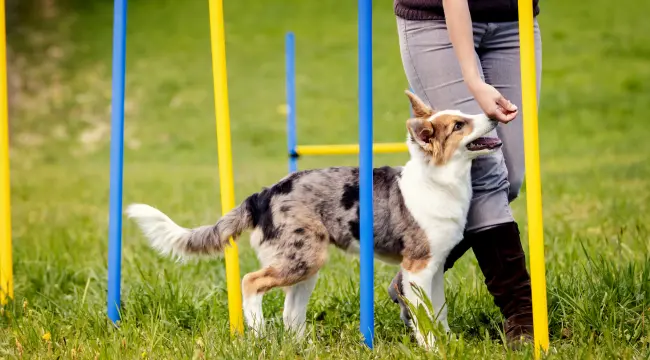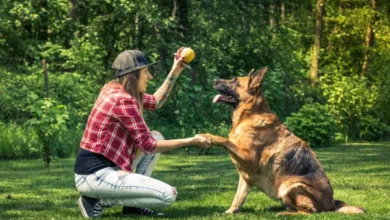
Proper dog training enables you and your pet to learn about one another while sharing positive experiences. This creates a lasting bond that’s respectful and trusting. Training teaches you how to communicate with your furry friend. Once you’ve built a strong bond with your dog and can communicate with them, setting boundaries for what is or isn’t acceptable becomes easier, reducing unpleasant/ unwanted behavior.
Effective training helps your dog learn how to conduct themselves in social settings, making other pets and people feel comfortable around them and leading to better experiences for both of you. It teaches your canine friend to listen to and obey your cues, helping avert possible conflicts with other pets, running into busy roads, or getting harmed in dangerous situations. Dog training has multiple benefits. However, some blunders can hinder your efforts. This post outlines seven common dog training mistakes you should avoid.
1. Neglecting Your Pet’s Nutritional Needs
The success of your dog’s training efforts heavily relies on what you’re feeding them. Neglecting your dog’s diet during training can negatively impact their learning ability, behavior regulation, and concentration. Proper nutrition is essential for your pet’s training success. It ensures your dog doesn’t become obese while preventing other chronic illnesses.
A good diet ensures a healthy pup and enhances their focus and concentration, which are essential for effective dog training. It boosts the pet’s energy and endurance levels. You can consult a dog nutritionist for guidance on the nutritious foods suitable for an active pup. Using resources like the Dog Help Blog, you can learn the importance of your pup’s diet and what you can do to ascertain their nutritional requirements are met.
2. Using Dog Training Treats the Wrong Way
Positive reinforcement or adding something enticing during dog training improves good behavior. It’s an effective way to reinforce exceptional behavior and teach commands. Dog training treats are a simple way to guide your dog to behave well and complete commands. Using these treats the wrong way can minimize their effectiveness and make them an undesirable reinforcement method that can obstruct your pet’s learning ability.
You shouldn’t use treats throughout training sessions to keep your pups engaged. They should only be given as a reward after the pet completes your command. Rewarding your dog after misbehaving encourages bad behavior. So, avoid giving them treats when they do something wrong. Using treats alone as reinforcement may cause your dog to become too reliant on them to do tasks. Instead of always depending on dog training treats, incorporate various positive reinforcements, like praises, into their training routines.
Once your canine friend learns all your commands but doesn’t respond to them because they’re stubborn or distracted, avoid using treats to recapture their attention. Doing so teaches them that they can use this trick to get treats from you. You can repeat commands to catch their attention and use your hand or a leash to direct them into specific positions.
3. Waiting too Long to Start Training
Delayed training negatively impacts your dog’s behavior and development. Failure to socialize your puppy means they won’t grow as confident and might be unfriendly, affecting your experiences together. Pups constantly learn from their surroundings while interacting with other pets. Dog training should begin around eight weeks or when they come home. This helps build a robust foundation, setting their adulthood tone.
Allowing your pup to start socializing early enough and offering them basic training builds their confidence. Since puppies’ attention spans are short, training will be more effective when using basic and simple techniques. You also need more patience and time during the training process.
4. Being inconsistent
Dog training inconsistencies result in wasted efforts because your pet might not learn or will take too long to learn simple things. Pups require consistency and a routine to learn and sustain the behavior and commands you teach them. In everything you’re training your dog to do or to avoid, remain consistent with the rules. The same rules apply in all settings because your pet may not understand why they’re allowed to do a specific thing in one environment but not the other.
When it comes to the command words you pick for particular rules, stick with those exact words every time you want your dog to behave a certain way. For instance, if you use the word ‘stay’ to tell your dog to remain in a particular location, use that precise word every time you want them to obey this command. This will keep your pet from getting confused. You should maintain consistency with rewards to reinforce good behavior. Learn to respond the same way each time your dog does something wrong.
5. Harsh punishment
Harsh punishment, including leash corrections that cause discomfort and electric shock forces your canine friend into submission and increases aggression. It also reinforces the bad behavior you’re trying to prevent. Aversive training induces fear in your dog and may result in them mistrusting you.
Effective punishment depends on a robust emotional state. Being harsh on your pup can leave them with a bad association with you and training. Exercise patience during dog training sessions, and consider repeating commands when your pet seems distracted. If they’re acting stubborn, end the training session, but on a positive note.
6. Cue poisoning
Cue poisoning happens when your doh grows an appalling association with specific cues. This association may cause your pet to hesitate to do what you expect, do something different instead, or ignore your commands completely. Poisoned cues may be due to misunderstandings between you and your pup or misreading their body language. You can fix poisoned cues by retraining those same behaviors but with different cues to eliminate the negative association.
7. Not developing a training routine
Regular training is crucial for the best outcomes, even after your dog has mastered your commands and cues. Create a routine and train one cue at a time to avoid confusing your pet. When you start teaching a new command, create time to revisit the old ones so your dog doesn’t forget. Incorporate some fun tricks into your sessions to make training more engaging.
Endnote
While dog training is beneficial, some errors can waste your efforts. Familiarize yourself with the common dog training you should avoid to ascertain success.



